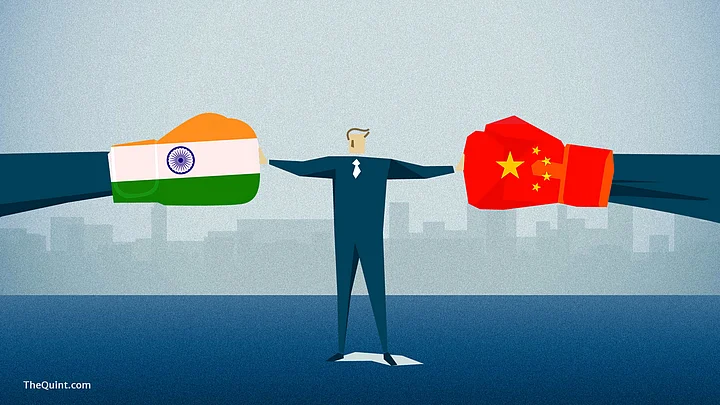China on 6 July accused India of militarising its side of the frontier.
A stand-off on a plateau next to the mountainous Indian state of Sikkim has ratcheted up tension between the neighbouring giants.
Troops from the two sides then confronted each other close to a valley controlled by China that separates India from Bhutan.
China said on 6 July that it was “absurd” for India to use the excuse of Chinese road-building to cross over their border, and accused India of militarising its side of the frontier.
A stand-off on a plateau next to the mountainous Indian state of Sikkim, which borders China, has ratcheted up tension between the neighbouring giants, who share a 3,500 km (2,175 miles) frontier, large parts of which are disputed.
Troops from the two sides then confronted each other close to a valley controlled by China that separates India from Bhutan – a close regional affiliate of India – and gives China access to a thin strip of land that connects India to its remote northeastern regions.
What is the Current Row?
In June this year, China refused to allow entry of Kailash Mansarovar pilgrims into its territory through the Nathu La Pass on the Sikkim border. The Home Ministry took note of the situation and asked the border authorities for a clarification.
China accused India of sending its authorities into its territories which was the reason for Beijing to close the Nathu La Pass route.
Later, India accused China of constructing a road in the disputed territory Doklam plateau, which lies in Bhutan. The Royal Bhutanese Army also raised concerns over the construction of the road in its territory. China, however, claims that Doklam plateau, an 89 square km pasture that falls close to Chumbi valley at the corner of India-Bhutan-China tri-junction and is not very far from the Sikkim sector, is within its territory.
The tension escalated after it was reported that Chinese troops asked India to remove two bunkers that were placed by India as a backup. It was later reported that the two bunkers were removed by China after they stated that neither India nor Bhutan had any claim over the region.
Soon, there was a standoff between troops of both countries with PLA and Indian Army sending immediate reinforcements to the region.
What is the Significance of the Doklam Plateau?
The Donglong (Doklam) is a tri-junction area near the Chumbi Valley. It is under China's control. However, Bhutan claims sovereignty over the area.
The terrain and weather conditions in the area provide India a tactical edge in Sikkim. Therefore, the construction of roads in Doklam area by China will strategically impact India.
Moreover, the construction of the roads will also bring Beijing closer to the Indian mainland in the north-east.
The inroads in Doklam will also impact India economically as the Chumbi valley, which is close to the plateau, has served as a trade route from Sikkim’s capital Gangtok through Yadong and Gyantse on to Dalai Lama’s court at Lhasa.
What Does India Say?
Defence Minister Arun Jaitley on 30 June said that the India of 2017 is different from the India of 1962. Jaitley was reacting to the statement made by China saying that New Delhi needed to learn from its 1962 military debacle.
"If they are trying to remind us, the situation in 1962 was different, the India of today is different," Jaitley said at India Today's Midnight Conclave in response to the reported remark by a People's Liberation Army (PLA) spokesperson.
India also informed China that road construction in Doklam area “would represent significant change of status quo with security implications,” according to a statement by the Ministry of External Affairs on Friday.
“It is Bhutan's land, close to the Indian border, and Bhutan and India have an arrangement to provide security. Bhutan itself clarified... China is trying to alter the present status-quo. After this, I think the issue is absolutely clear. To say we will come there and grab the land of some other country is what China is doing and it is absolutely wrong," Jaitley said.
What Does China Say?
China, while refusing access to Indian pilgrims, had said that Indian troops had entered its territories. On 28 June, China warned India that future visits of its pilgrims to Kailash Mansarovar through the Nathu La pass will depend on whether it will “correct its errors”.
Beijing later termed the construction of a road in the Sikkim sector of the Sino-India border as “legitimate”, asserting that it was being built on Chinese territory that neither belongs to India nor Bhutan and no other country had the right to interfere.
China also hinted that India was objecting to its efforts to build the road in Donglang area of the Sikkim sector on behalf of Bhutan, which does not have any diplomatic ties with Beijing.
China had lodged a protest with India over the alleged “crossing of boundary” by its troops in the Sikkim section and demanded their immediate withdrawal.
The Chinese embassy in New Delhi, on 5 July, said China was willing to discuss the possibility of alternative arrangements through other routes for Kailash Mansarovar pilgrims, who had planned the journey via Nathula Pass, suggesting that the mountain pass in Sikkim was not open anymore for the pilgrimage.
